Archive: July, 2016
Parental beat-down
posted by Jeff | Sunday, July 31, 2016, 8:18 PM | comments: 0Diana and I have had a rough summer as far as parenthood goes. Our darling little boy has learned the art of rage, and it comes fast and without warning. It mostly involved shouting on his behalf, but there has been some hitting and head butting along with it. The push-pull action at 6 has become more extreme than it ever has. While he'll be fiercely independent about some things like putting on a seatbelt or taking a shower, he'll flip out if he doesn't get help instantly for a toy that isn't doing what he'd like.
As know-it-all non-parents, of course we assumed that kids who misbehave do it because of some parental action (or non-action). While we now know it isn't that simple in the context of various behavioral and developmental disorders, and yes, including ASD, we still look to our past to understand what we may have done to encourage the behavior, so we can correct it. On the one hand, I think we've mostly given him the chance to "struggle," so we haven't shielded him from adversity. I do recall one professional or another telling us however that there would be things where he simply can't logically reconcile a situation the way others would, so he will likely need help developing coping strategies in those cases. On the other hand, it's quite possible that he doesn't understand consequences because frankly we don't enforce them very well. We let him push us to the limit, and then he complies. That's definitely on us, so we've had to start issuing concrete consequences for things immediately, spelling them out in the only warning and then following through. The shouting and hitting, however, have immediate consequences.
I think our frustration peaked recently, and especially on the last cruise. That's a hard time to have a realization, when it's difficult to enforce any kind of consequences. What do you tell him, "No, you can't be on the boat anymore?" We'll have to come up with some proactive plans the next time we vacation.
Our fatigue is partly rooted in summer, I think, and it would be a lot worse if Diana didn't enroll him in various activities throughout this time. I'm grateful that we can afford to give him those opportunities. Our neighbors and his classmate moved a few blocks away, so his most convenient social connections aren't as convenient now. Other area friends of course are doing stuff and taking vacations, so that's hard too. We look forward to him having the structure and regular schedule of school again. Meanwhile, we need to remember to take time off now and then and have regularly scheduled grownup time. I don't know why we forget to do this. It's not like we started being parents last week.
Interior design challenges
posted by Jeff | Sunday, July 31, 2016, 5:17 PM | comments: 0We went through a pretty serious HGTV phase, lasting through our 18 months or so back in Cleveland and into our first year in the new house in Orange County. It was the makeover and renovation stories that we liked, because it was amazing to see how beautiful these living spaces were. We don't watch the TV shows that often anymore, but we do go through the model homes in the neighborhood as new ones pop up (I think there are 10 builders now). They make me feel like we really suck about furnishing and decorating, especially after being in the house for two years.
I do have some excuses though, not the least of which is that we let Simon kind of stretch out all over the place. He has toys in five places right now, or six if you count the one or two things that end up in my office. The level of room engagement varies, and I admit that we've let him have a little too much at times. There's a part of me that wants to say, "This is your area, and the living room stays clear," but as an only child, that would mean he would be playing alone a lot of the time.
At some point between the holidays last winter, we decided to go all-in with an Ikea BESTÅ renovation for the TV and such. I wanted to ditch the old stand that we had with doors because it was baking our Xbox, and everything else in it. I also really wanted some display shelves mounted to the wall, so when it went on sale, we did that. Some people think the Ikea stuff looks cheap, but I think if you do it right, it's pretty solid. Mind you, I felt good about it until I saw my brother-in-law's custom built-in that he did at his new house. It's completely beautiful. I have to remind myself that he's an architect. Combined with some custom curtains and pillows that Diana made, the living room is definitely comfortable. We still would like to get some better light fixtures, a coffee table and a new chair.
The dining area, which is really all the same room, still lacks a good table. We've just not found one that we like. We did add a wine rack and cabinet that matches the kitchen pretty well. Diana has added accents above the cabinets as well. We still think we want a backsplash in there, but again, haven't found anything we like.
Simon spontaneously said he wanted his room to be Star Wars themed, and Diana responded by jumping into action. She just finished painting the walls in a two-tone, with a dark blue in the top two feet, and glow-in-the-dark star decals. She even painted over the cheap dresser that once doubled as his changing table.
Unfortunately, we hate our room. It's the room with the most expensive floor, too. We originally were going to do a light blue that looked terrible, then ended up doing the whole thing a dark blue. We have nothing on the walls. We want an accent rug, but haven't found the one we want. And it occurs to me that our light furniture may clash with the floor. I really wanted the tray ceiling, but we had upgrade fatigue when we ordered the house. I did see in a model a way to simulate that depth, by framing off part of the ceiling and painting up to it. We may still do that.
The one bright spot is that my office is comfortable and decorated, mostly with stuff we already had. I bought some picture frames to match some others I already had, and it's a wonderfully comfortable place. Since I work from home a minimum of 70% of the time, that's a good thing. I still would like to get a big closet to hide all of my crap, but otherwise it's a functional space.
I give us slack because on TV, they pay people to do this stuff. Heck, so do the builders in their models. Assuming that we aren't going anywhere, we've got time. It's not a race.
When your parent remarries
posted by Jeff | Saturday, July 30, 2016, 10:26 PM | comments: 0My mom got married today to a gentleman from the next "village" (the subdivisions of The Villages). This comes a few years after my step-dad passed away. I imagine it would be weird to be dating in your 60's, but the cool thing about The Villages is that everyone there is retirement age. I'm happy for her, and that environment has been good to her in so many ways.
Diana's dad is also getting married later this year. She lost her mom shortly before we met for the first time, and in fact we were connected online just before that. I never got to meet her, but her family assures me that she would totally have understood my personality and sense of humor. I think that's a compliment. My new step-mother-in-law was a friend long before this, and also knew her mom. I'm glad they're making it official.
When I got divorced, a decade ago, I was really dating for the first time. I mean, obviously Stephanie and I dated, but I didn't seriously date anyone else. (I know... people who knew me at the time may debate this, but long-distance puppy love and random make-outs aren't really functional relationships.) There was a weird conclusion that I had reached when talking about my fears and apprehension about dating to my therapist at the time: All relationships end in a break-up or death. How's that for morbid? I know, it sounds horrible, but really, there was something completely freeing about acknowledging that. It's not at all romantic, but it's a small and finite list of things that could happen.
As it turns out, there is something kind of romantic about this. If you lose your spouse, probably one of the worst pains you can endure, and you find someone you can love enough to marry after that, then lightning has struck twice. That's pretty awesome. I feel like I've been incredibly lucky to have all of my serious relationships, but there's something to be said for having another chance, especially later in life, following incredibly awful circumstances.
Is racism environmental? Does it even matter?
posted by Jeff | Friday, July 29, 2016, 6:56 PM | comments: 0One of the things that I found most difficult about my teen and college years was trying to understand how people could be racist. It's easy enough for me to say that it isn't logical, but as a learned behavior, environment obviously matters. I can anecdotally observe that there are fewer people who are blatantly racist every generation, especially if you compare my grandparents' generation to Millennials, for example, but where does it come from?
As much as I can write it off as something that's simply illogical, I'm willing to admit that maybe my own experience leads that thinking. Starting in second grade, I was a part of the desegregation effort in Cleveland. I was bused across town so the schools would not be overwhelmingly black or white. Naturally, as a kid that age, other kids were just other kids, and if it weren't for the fact that school administrators weren't always taking race counts, we wouldn't know any better. It wasn't until I moved to an almost entirely white suburb in high school that I encountered racism, and it was shocking.
College ended up being surprisingly diverse for a school in rural Ohio, but involvement in residence life and a robust international program certainly helped with that. It was my first exposure to the non-Christian religions, and a broad group of people from India, Japan, the Middle East and Europe. And of course, working in software, I don't have to tell you that it's not entirely unlike working in the United Nations. I feel very strongly that this diversity has given me a more complete world view.
Here's the thing though... I really can't reconcile the idea that a grown adult can engage in hate based on race, religion or any other factor, just because they may have been subjected to it in their youth. Eventually you reach a point in life where you should be deciding for yourself what you want to be, and how you want to exist in the world. There is no upside to racism, misogyny, homophobia or any of the other -ism's. None. You gain nothing.
Revolutions usually fail, but a hundred small victories succeed
posted by Jeff | Tuesday, July 26, 2016, 9:05 PM | comments: 0The years that I worked at Microsoft were a particularly fascinating time for the company (still is, actually). The company was looking for its new purpose in life, beyond the reliance on the cash cows of Windows and Office. One of the things that struck me as odd, coming from the outside, was the arrogance with which a lot of people approached software development. "This is how it's done, this is software development," they would tell me. I would shake my head, as someone who worked in teams that delivered software on a monthly or even more frequent basis, because these words would come from people who shipped software once a year, at best. In their minds, all of the overhead, armies of people, thousands of meetings... this was normal.
The group that I was hired into wasn't like this, of course. We were in the mode of delivering stuff quickly and frequently, and getting feedback from our users constantly. For many of us, especially with experience from outside the bubble, we knew that this was the way the company had to roll in order to evolve, maybe even to survive. I had a lot of conversations with my manager about this, because it was fascinating to see the transition. It drove me a little nuts though that it was slow. I had been in my share of jobs where this need for change was urgent, and I was impatient.
My boss had been at it though for about a decade. His advice on the topic has stuck with me, too. He was effective because he was patient, and methodically built consensus, one small victory at a time. He formalized what I suppose I always knew: You can't show up among other people and expect a revolution. It's true that I have, for much of my adult life, not really practiced this, and probably pissed off more than my share of people. In my current and previous job, something clicked, and I became an effective agent of change myself, and I'm proud of the things I've accomplished. Getting people to come around to your way of thinking is a slow process, and you undoubtedly have to make some compromises, but you can get it done.
This seems like an important topic in light of the current political climate. Putting aside all of the hateful, divisive dipshittery for a moment, the strong convictions of a portion of the Bernie Sanders fans have turned bitter and unable to "settle" for anything less than their guy and his policy. It's not fair for me to characterize this as immature idealism, because being an idealist is what most people do in their younger years. Experience is what gets you to my point of not going for the revolution. Revolutions fail most of the time, and that's true throughout history. But incremental change, that's possible, and as time passes, you can move the world closer to your ideals. That's how it's done. "Fuck the system" is masochistic, and it causes you more pain and angst. Working the system, bending it and changing it gradually, works.
Small victories. That's how you change the world when not everyone agrees with you.
When you don't feel like you can make a difference
posted by Jeff | Sunday, July 24, 2016, 3:39 PM | comments: 0The world is probably not as awful as people are making it out to be. If you go strictly by the numbers, the world is a much better place than it was even 10 years ago. It's not without its problems, but in aggregate, it's not worse off.
This doesn't mean there isn't plenty of work to do. In fact, the progress we have made as a species wouldn't be possible if it weren't for the people who have taken up the cause to advance us. I don't know what really motivates people to devote energy to world improvement. For me, at least, I know it was easier when I was in college, when my biggest concerns were skating by to pass classes, obtain beer and hope that there were girls who wanted to play with my dingdong. There was plenty of energy left over to change the world.
Life gets a little more full over time. Career, relationships, children take up significant portions of that energy. I find that with age, I'm more likely to acknowledge that somethings are not simple. Some problems require complex solutions. Whereas it used to be easy to just say, "Racism is bad, stop racism," now I have to think about the underlying socioeconomic issues, public policy, history and a dozen other things to understand why racism is even still a thing. How do you instigate change when the problem is hard?
Politics in the general sense are like this. The left and right are both in constant blame mode (blaming the rich and brown people, respectively), and the solution is to stick it to those groups. As a rational person, I can't take up either side as a cause. And when people around you treat these factions as a sports rivalry, blindly and almost religiously adhering to one side, there's little you can do to change that. Arguing with people on the Internet gets you nowhere, and trying to win the hearts and minds of people who don't want to consider any bit of nuance is exhausting.
And yet, as a parent, you don't want your kid to grow up in a dysfunctional shitshow of a world that is always hellbent on hating someone. You feel like you have to do something, you know, for the children. How do you do that when the act of parenting and all of that life stuff pretty much expends all of the psychic energy you have?
I don't have an answer, but I think about this a lot. I've often considered that your scope of influence is not really that critical to feeling like you add value to the world, so maybe doing what you can do is adequate. It just feels like an uphill battle.
Press: Truthful, not neutral
posted by Jeff | Friday, July 22, 2016, 4:00 PM | comments: 0I've been extremely disappointed in the mainstream press during this election cycle. I think the bizarre rise of a narcissistic demagogue like Trump is something shared by a willfully ignorant public and the press. I can't do much about people who want to be ignorant (and endorsing a human who is a racist misogynist just because he "speaks his mind" is most certainly ignorant), but I'm perfectly content to lay into the people who aren't doing the work necessary to be called "journalist."
The other night, Christiane Amanpour, of CNN International, appeared on The Daily Show and nailed down exactly the problem with the press. She said there's a difference between being truthful and being neutral. Correctly, she points out that being neutral implies moral equivalency between two sides. Equivalency, by extension, grants legitimacy. That's the thing that I've been trying to articulate. Keep in mind that I'm taking about "real" news outlets, like TV network news (not the abomination that is cable "news"), the big newspapers and stuff picked up by the syndicated services.
Is truth surfaced elsewhere? Yes, but not in the places that one typically would go to for news. Countless blogs that pander to a particular political orientation do this, but they only do so when it suits their echo chamber. Comedy and entertainment shows like The Daily Show also do it, with a somewhat better record of bipartisan shaming, even if the level of batshit crazy has certainly peaked on the right. But the problem is that we used to rely on Peter Jennings and Tom Brokaw to be the people who set the standard, less interested in being neutral and indeed looking for truth.
Something interesting happened in the democratization of media that was the opposite of what I expected. Before the Internet, there was a certain amount of trust placed in the press because it was scarce. There were a limited number of TV licenses, and it wasn't cost effective to have more than one newspaper in most markets. While this scarcity seems like a bad thing, there was a sense of responsibility among the practitioners of journalism to uphold a sense of truth. That's not to say there wasn't a certain amount of bias (we are talking about human beings, after all), but there was definitely a desire to be truthful and not neutral.
The Internet, along with virtually unlimited cable channel availability, made the scarcity problem go away. It also made it hard to recoup the cost of real journalism as the audience fragmented, which gave way to talking heads that were paid to give opinions. Many organizations focused on a particular faction because they could make it profitable, the most obvious example of this being Fox "News." Pandering to an echo chamber is lucrative, as it turns out. The remaining players, especially network TV news, lost their way to being neutral, not wanting to be lumped in with the cable news and blogs. Neutral isn't what we need. If it smells like bullshit, then call it that.
Our Disney relationship
posted by Jeff | Friday, July 22, 2016, 9:00 AM | comments: 0I had to renew our Walt Disney World annual passes yesterday, which marks three years of living in Orange County. We went to Epcot the night before, and it was the first park visit we had in probably a month, because of our time away on the cruise, work and just a natural lag. It's unusual to go that long. This year we opted for the lesser "gold" tier passes they introduced last year, after we renewed. They have a reasonable blackout date range, specifically the last two weeks of the year and two weeks in April for spring break. These are times we never go anyway because of the crowds.
It got me to thinking though, what is our relationship to Disney? It's extensive, though I don't know that I would consider us super fans. I mean, none of us have a tattoo of the castle or anything. But we consistently enjoy ourselves at the parks, and for the frequency of our visits find it to be a pretty good value. It's an easy way to catch up with friends from up north since everyone seems to get here eventually. Given the proximity, it's fair to describe WDW as our back yard. It's especially surprising to see how much we hang out at Epcot, in large part due to Food & Wine and Flower & Garden. So much good food and music.
Our biggest Disney spend is with the cruise line. Doubly so this year, with the Alaska cruise (ouch!). Their boats are my happy place, and we have a consistently good time on them. For us the expense is worth it, and the convenience for the itineraries leaving Port Canaveral is pretty hard to beat. These trips have the best beach days ever. I'm disconnected, and I don't have to think about anything. They even tell me when to eat.
The films are something we regularly consume, given our 6-year-old. I was really enamored with the musicals of the 90's, but lost interest until the more recent renaissance started. Now that the company owns Lucasfilm, I suppose we're much bigger Disney movie fans than we were. I know there are people who cringe at Disney's massive influence on entertainment, but I think the quality of what they offer is generally pretty high. It's OK if art is popular and profitable. I won't apologize for enjoying Tangled.
It is strange to see how much money Disney does get from us. Annually, it's second only to Target (where we buy much of our groceries). This year, because of Alaska, Disney may actually win. That's pretty crazy, that one company can be the single largest recipient of the part of your income you spend.
Rethinking cameras
posted by Jeff | Sunday, July 17, 2016, 11:05 PM | comments: 0I've sunk a lot of money into Canon camera gear over the last dozen years or so. Well, technically I did before that as well, but it was for film gear, and the lenses I had then I have long since sold. But way back in the summer of 2002, I bought the D60 body, an "affordable" DSLR for the masses, and I was hooked. I traded up after that to a 10D (higher sensitivity), and eventually I scored a 5D, full-frame, in 2008. Along the way, I picked up some nice mid-range "L" lenses, including the 24-105mm f/4, 17-40mm f/4 and 70-200mm f/4. I also have a wonderful 50mm f/1.4. In 2009 I also bought a second body, a 7D, because it could record video.
The great news is that these things are still awesome, and unlike most technology, aren't really at risk of being obsolete. Sure, you can get more pixels, more stops, but these things get it done in most every situation. I even discovered last February that I could shoot portrait stuff if I really try. I've always liked photography, since my dad put his classic Nikon F (as in, no number designation) in my hands in 1990 so I could shoot for yearbook. It's a hobby that I often come back to, then forget, then go back to again.
But the honest truth is that sometimes I don't want to be the photographer, and I really don't want to carry the gear around on vacation. I thought a lot about this leading up to our Alaska trip. Capturing moments only works if you have the camera with you, and the truth is that an SLR is big and heavy. The results are often lovely, but you've gotta carry the goods. In my mind, I used to think as I did with video cameras: If it's not on your shoulder, it's not a "real" camera. For still photography, I felt that way about SLR's.
Still, I've had a series of small Canons with fixed lenses, the last of which was a wonderfully compact S90 that I bought in 2010 right after Simon was born. It had enough manual control to satisfy my control desires, it recorded raw format files and it easily fit in my pocket. Last year it was starting to bother me a little because of a stuck pixel, but a potentially awesome compromise came up last year.
Back in 2012, when I bought my AF100 video camera, there was excitement in the fact that I could put potentially any lens on it. The mount was for micro-4/3, but with an adapter I could also put my Canon EF lenses on it (with a significant field crop, mind you). However, for more journalistic, run-and-gun situations and docs (like my Holiday World mini-doc), I needed a lens that was compact and could do a range of things. While the cost was painful, the 12-35mm f/2.8 (24-70mm SLR equivalent) Lumix lens was perfect for this. It can do beautiful, soft depth of field, and it's super sharp when you need to fill the frame with something.
As it turns out, Panasonic was making cameras that use the same mount (Olympus, too), and they had a nice, relatively compact camera that could use the same lens. Mind you, this camera body was less than half the cost of the lens, but I could use this fantastic glass on a small camera! So that's what I did. The included lens is the same focal length range, but it's not a continuous f/2.8 throughout the zoom. It's perfectly adequate in outdoor light, if you're not trying to isolate a certain depth, though it gets kind of soft in the corners with full-frame shots of stuff. So marrying this body with the good lens isn't pocket-worthy, but it's still way smaller and lighter than the equivalent with one of my SLR's.
I've taken it with me on a two cruises now, including the Alaska trip, and I love it. It works reasonably well in low light, but you do have to be a little more careful about overexposure. I've captured some great portrait style shots of my kid (and his cousins), and it looks great using the wide angle as well. They also make a 35-100mm f/2.8 (70-200mm SLR equivalent), but I'm trying to resist buying that because it's a expensive and I don't think I'd use it enough.
You don't get something for nothing with the smaller camera, in terms of noise and such, but the idea that you could get image quality this good just a few years ago was not obvious. Unfortunately, history is repeating itself, so while micro-4/3 is a lens mount shared by a few manufacturers, Canon and Nikon are of course doing their own thing. I had the lens anyway, so this camera, which unfortunately they stopped making already, was a pretty good move. Physically bigger cameras aren't always necessary.
Our Alaska adventure on the Disney Wonder, July 2016, part 2
posted by Jeff | Sunday, July 17, 2016, 11:06 AM | comments: 0In part 1, I wrote mostly about the onboard experience on The Wonder, so here I'll talk about our stops in the ports of Skagway, Juneau and Ketchikan.

Our first and most northern stop was in Skagway. This little town of 850 people sits wedged between the mountains at the foot of a long trail and railway that heads up into White Pass at 2,888 feet, where you connect to British Columbia in Canada, and further into Yukon. It's a gold rush city that mostly is a tourist destination. It's filled with shops and various forms of entertainment, and arguably the most important business there, the rail line.
The excursions on the White Pass & Yukon Route Railroad are a lot of the reason that the Alaska cruise itinerary was so appealing. Having a 6-year-old naturally means a love for trains, and it's a pretty amazing way to see sights that you can't otherwise see very easily. There are a number of different trips offered, going to different lengths, but ours stopped at the Canadian border. It's about 20 miles of track to the summit, which means it's somewhat steep in places to get to almost 3k feet. There is a lot of history, as you can imagine, in the trail as it stood, as well as the railway itself, which was built just before the turn of the century. Lots of death, too. There's a cross erected on a ledge that's actually a house-sized boulder that fell on a couple of guys and their animals during construction, for example. There's a beautiful steel bridge up there that was an engineering marvel for its time, that has since been retired.
It's neat to see how the line snakes up the sides of the mountains. As they run a number of trains at any given time, you can see another one either above or below you, miles away. There's a particularly breathtaking view near the top that looks all the way back down to the town, where you can see a little dot that is the cruise ships. Just after the summit, next to a 5-mile long lake, there is some room for a second track where the trains do a ballet of passing each other and heading back down, reversing by moving the engines from the front to the back. It's a neat trick, because the seats in the passenger cars simply flip the backs.
I was struck by the sheer scope of what nature created there, and also what humans achieved in 1898 in getting up there. I suppose greed gets partial credit as a motivator, but it reminds me that people have been able to achieve great things when they wanted to. In light of all the terrible things going on back on the mainland, it helped me keep perspective. Mother nature is pretty good at reminding us how small we are.
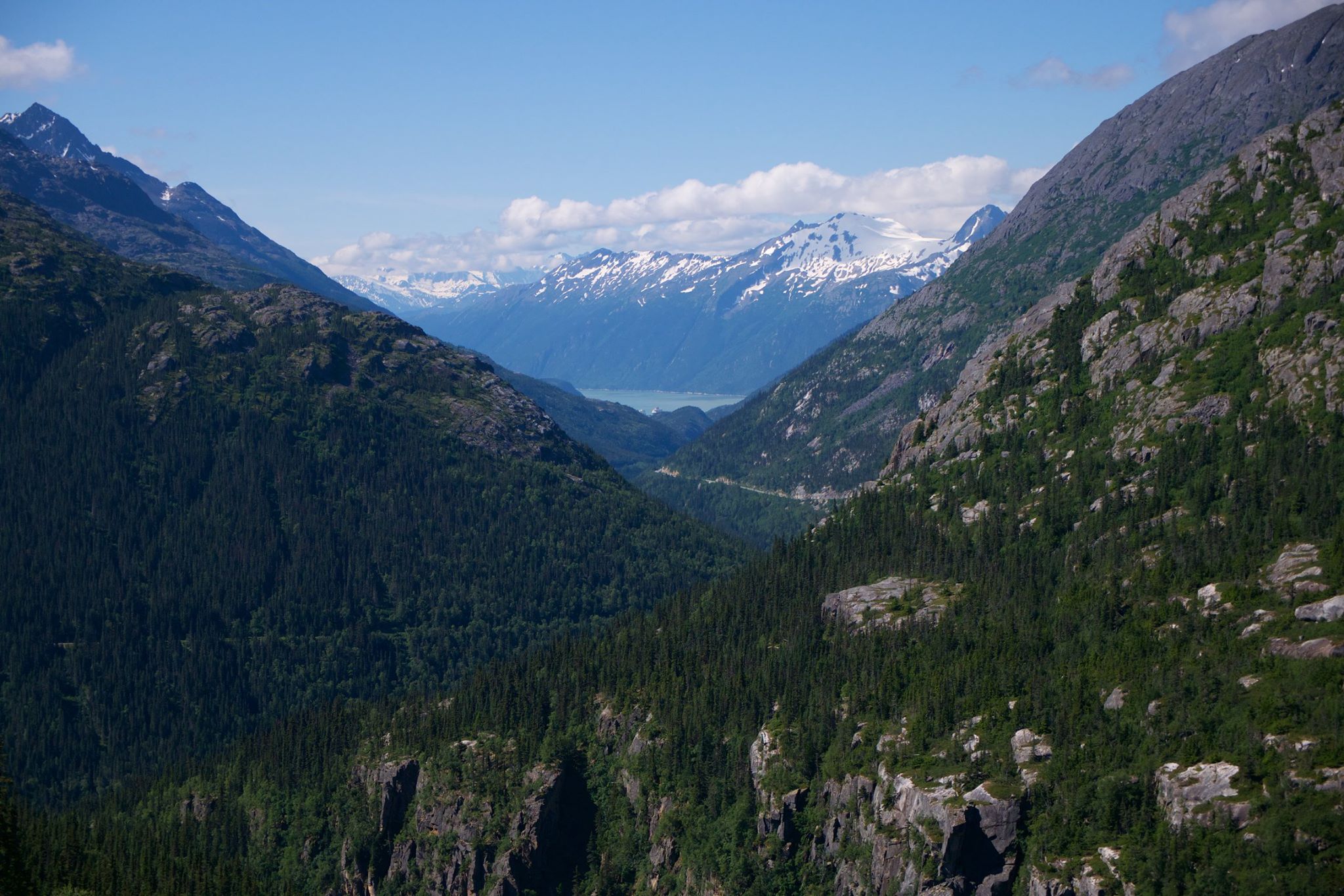
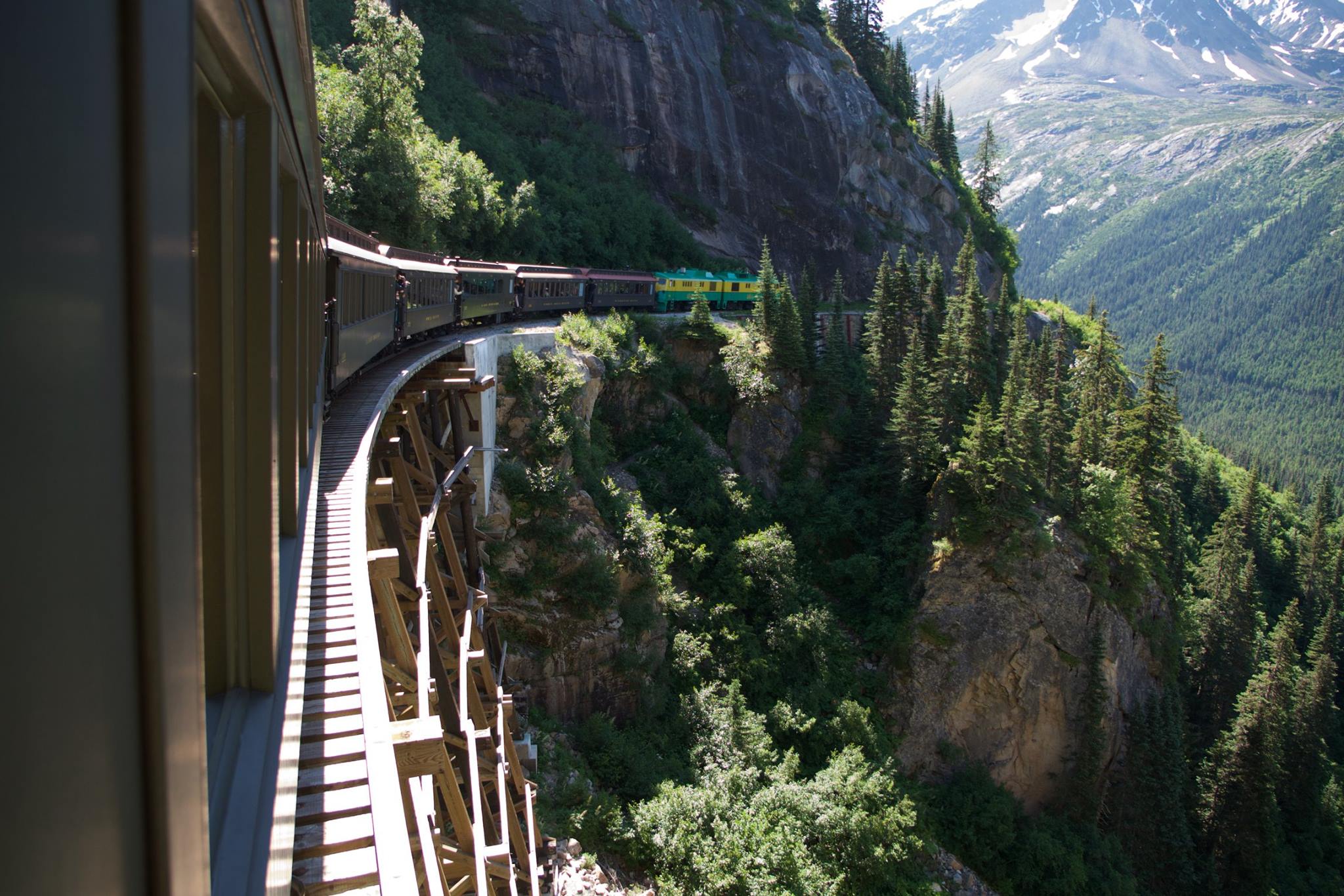
We started to walk around in Skagway, but Simon and I got pretty bored with it quickly. It's mostly a bunch of shops selling a bunch of crap. Diana was motivated, however, for some specific items and looked around a bit more while Simon and I returned to the ship. We were blessed with nearly perfect weather, so we hit the ice cream machines. That cold that I mentioned before was also starting to wear on me a bit, so I crashed for a bit before dinner, the onboard Frozen themed party and that night's theatrical show.
The next day put us in Juneau, the capital of Alaska. The weather was dry but cloudy, and the cold symptoms were definitely slowing me down. We booked a short excursion that bused us out to the national park to see the Mendenhall Glacier, then offered quick shuttle service a few blocks from the ship to the Mt. Roberts tramway. Being the government seat for the state, it was somewhat entertaining to hear our various guides throughout the trip regularly disavow Sarah Palin. I get the impression that Alaskans are very anxious to distance themselves from their former governor.
The national park service has a nice setup with a short nature trail and a longer trail that takes you to the Nugget Falls, along with a visitor center. A sign there points out that the glacier was actually 1 3/4 miles closer to the center when it opened in the late 50's, obviously a symptom of climate change (the difference, looking at the photos on Wikipedia are staggering). Unfortunately, the tour we booked gave us only about 90 minutes, so we couldn't go out to the falls. If we ever do this itinerary again, we'll find a way to spend more time there.
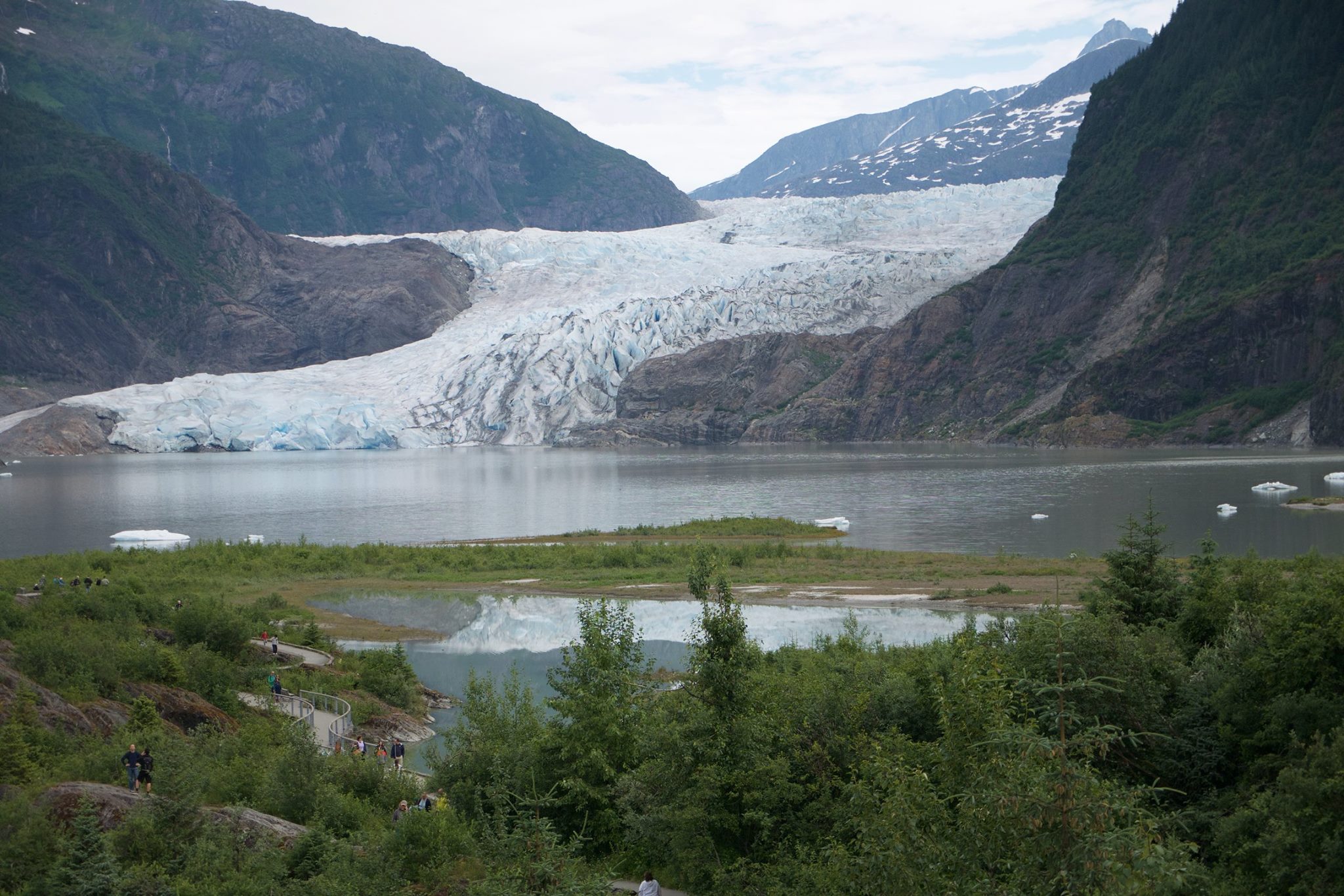
After visiting the park, we headed up the mountain on what is apparently the steepest and/or tallest tram of its kind in the US. While it was a little cloudy, the views were still stunning from up there. There was a longer tail that went to the summit of Mt. Roberts, but my cold made me disinterested in going much further than the closer trail loop we did. After going back to lunch, where seaplanes were taking off and landing at eye level next to deck 10 of the ship, I crashed for a long nap while Simon and Diana went and did some laps on the tram. Fortunately, that evening was a turning point in the way I felt.

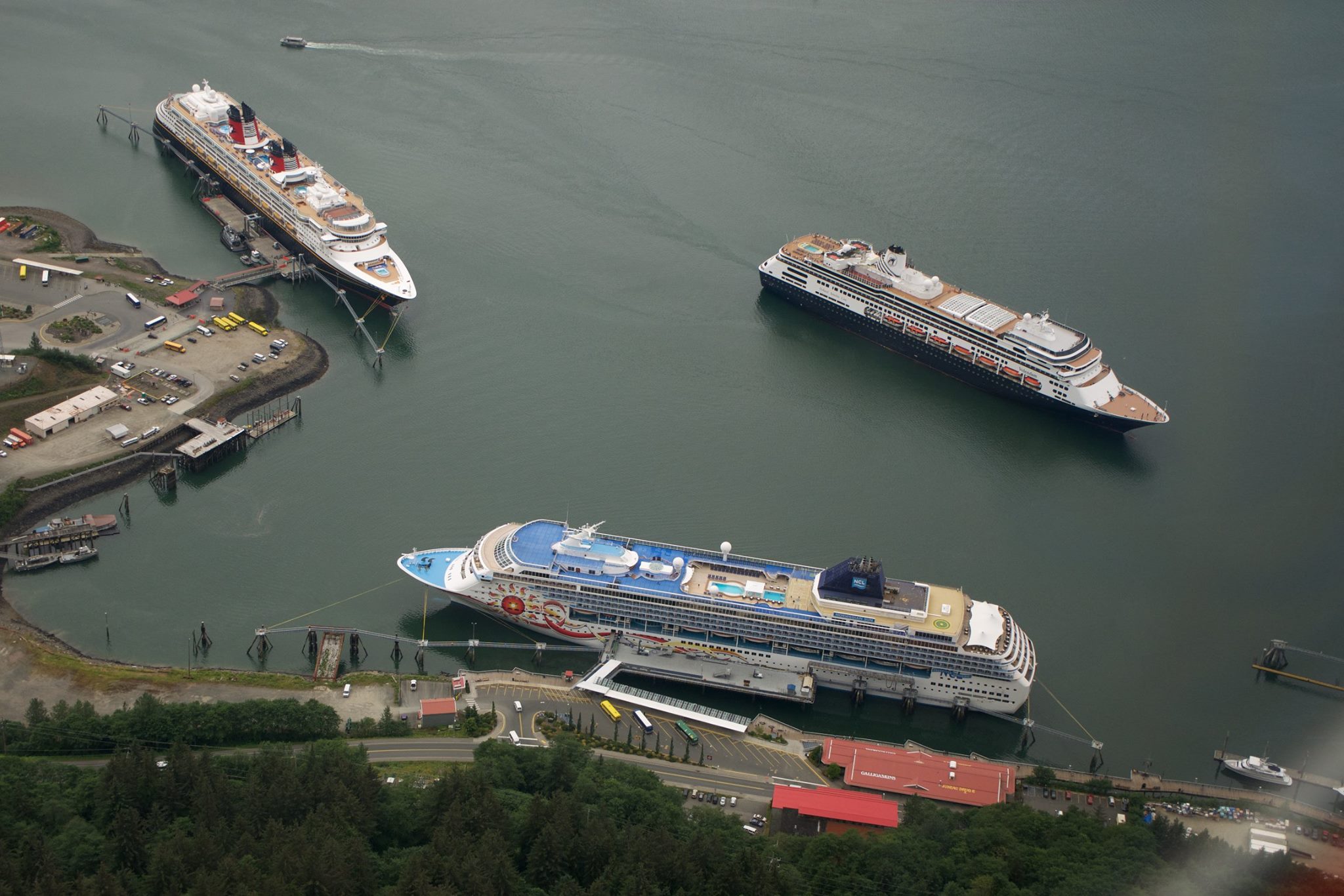
Our final port was Ketchikan. This is a largely blue collar fishing town mixed with a robust tourist business. We didn't plan anything in advance for this port, though there was a lot of buzz about the lumberjack shows a few blocks from the dock. They warned us the night before that it rains pretty much every day in Ketchikan, so imagine our surprise when it was sunny and warm. Like the other ports, the immediate area near the waterfront is filled with shops and jewelry stores. That said, this town has a very vocal group of local business owners intent on letting you know that they're local. We noticed the duck boats driving around and various busses and carts meant to take people to different things, but we decided instead to just walk around a bit through some of the local parks. In particular, we walked along Creek Street, which is, as the name implies, a series of shops along a creek with a connecting boardwalk. I didn't spot any salmon, but they apparently hang out here.
We didn't spend a ton of time in town, but we got a lot of walking in, and as I was feeling infinitely better, it was nice to be moving about. We were pretty content to return to the ship as Simon was being difficult.
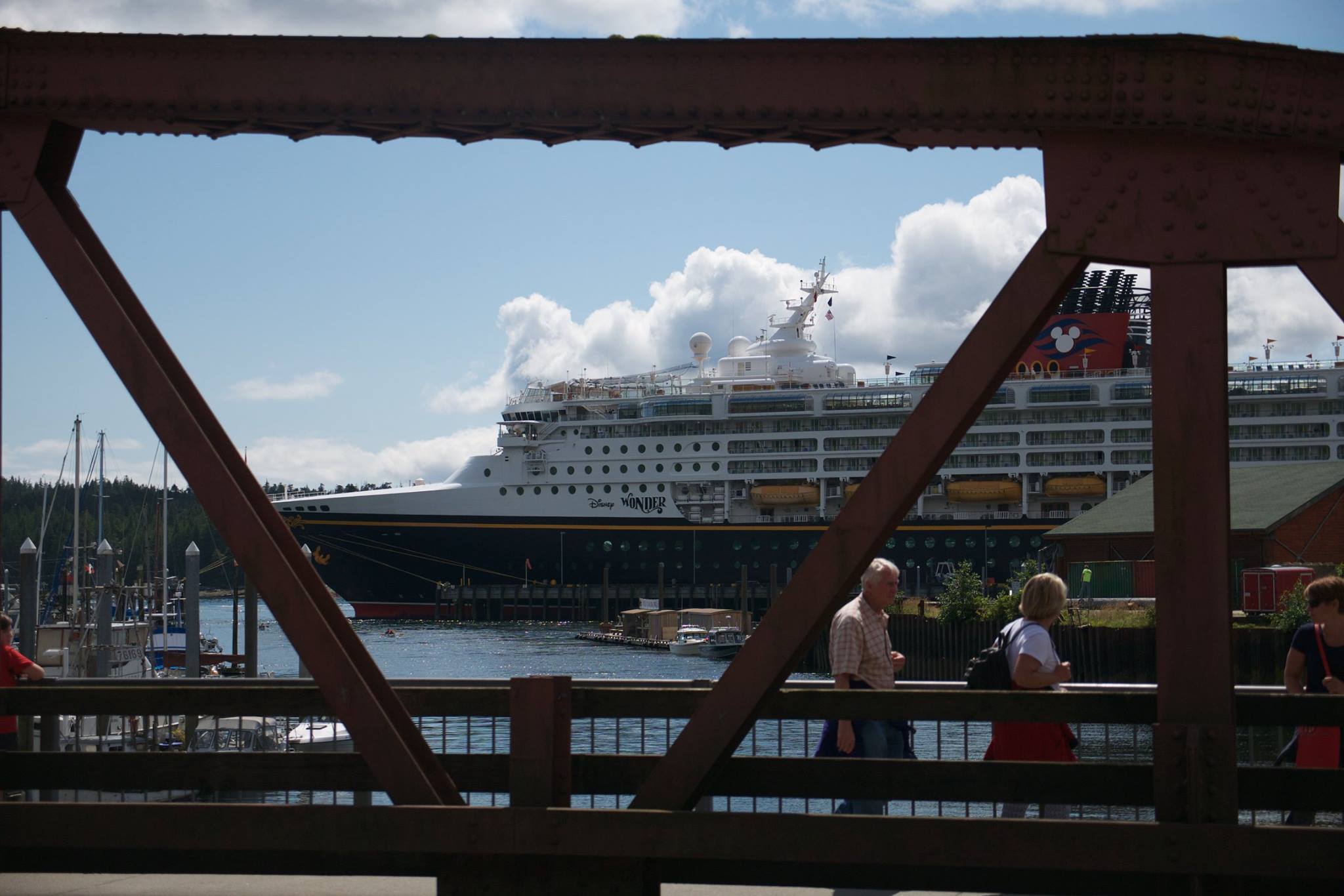
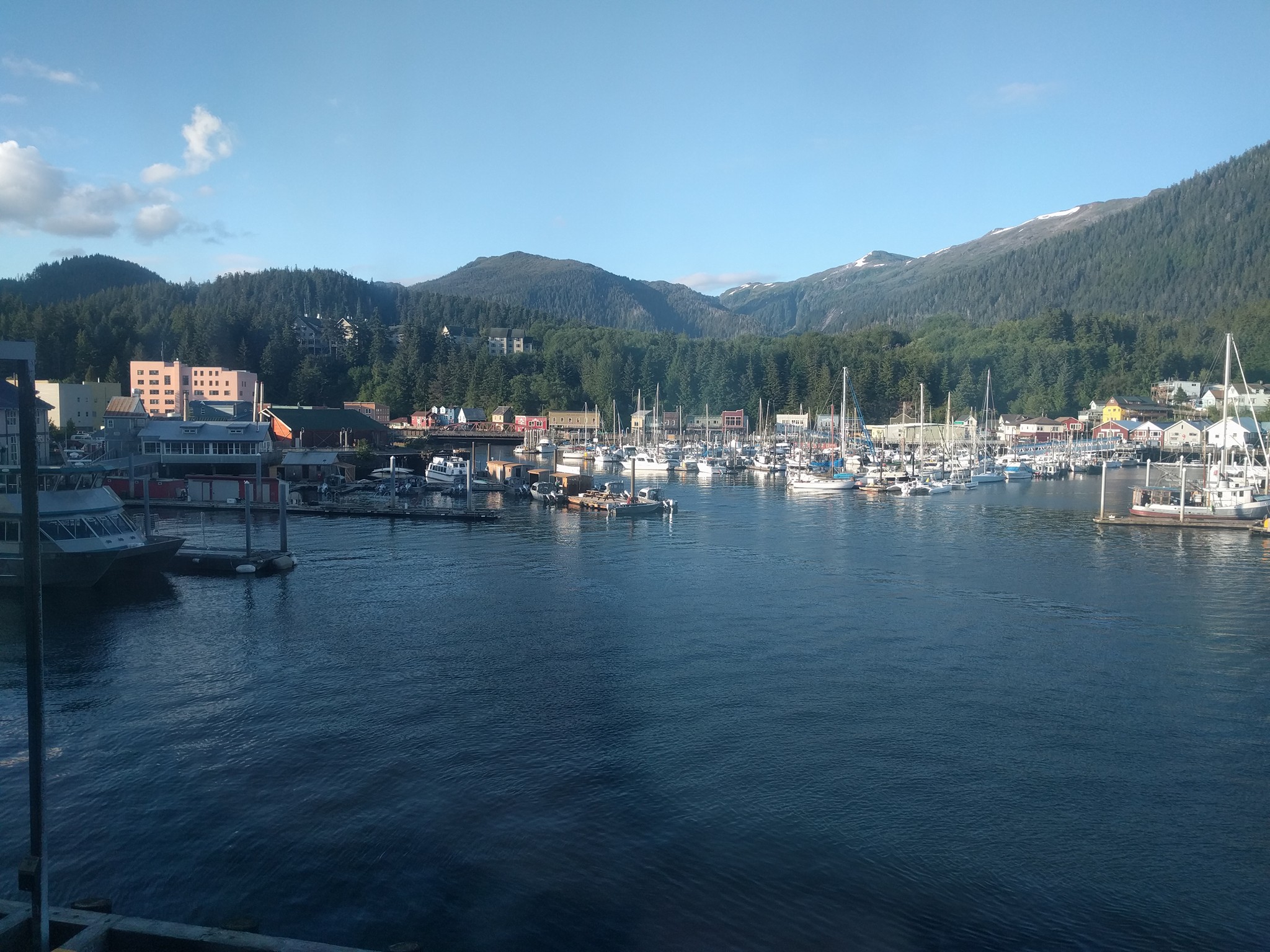
Exploring the ports on a cruise is new territory for me, despite having eight prior sailing under my belt. All of our cruises were 3 and 4-day Bahama itineraries that only stopped in Nassau and Castaway Cay. We never get off in Nassau, partly because of its reputation, but mostly because it doesn't offer anything that we can't enjoy on the ship (yes, I realize we could go to Atlantis). Alaska is so opposite of the tropics. It's just insanely beautiful, and navigating through the inner passages in particular is wonderful. The locals are generally very friendly. If there's any big takeaway from this trip, it's that it will be a great way to sample Europe, hopefully in the next few years. But I also want to do this itinerary again at some point. I realize that duplicating the weather isn't likely, but still, what an amazing place.
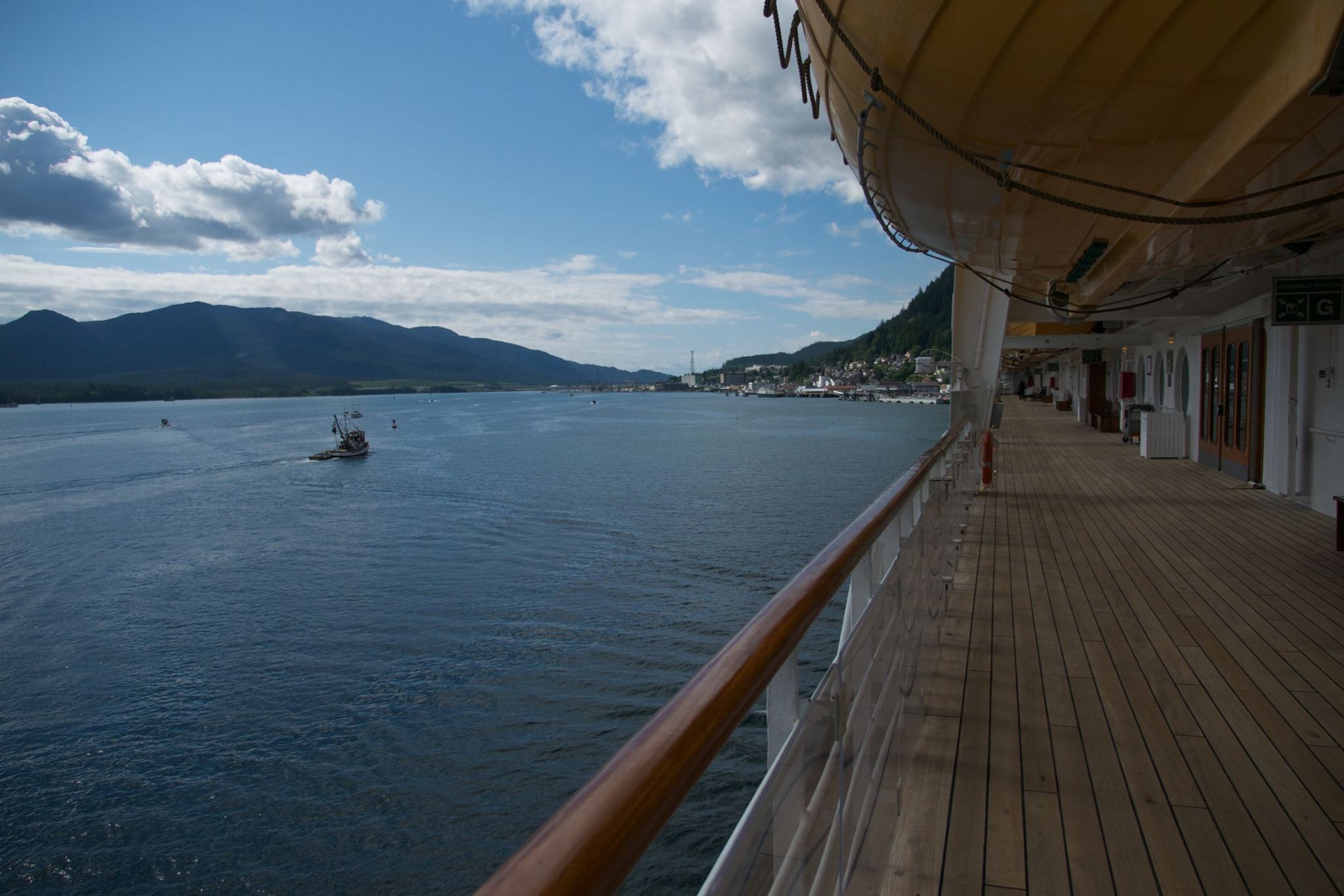
Our Alaska adventure on the Disney Wonder, July 2016, part 1
posted by Jeff | Saturday, July 16, 2016, 3:00 PM | comments: 0OK, I definitely need to commit some of this fantastic trip to a blog post. I'm going to split it into two parts, the first part being about the time on the ship, including the voyage up Endicott Arm, and the second part about the time spent in Skagway, Juneau and Ketchikan. There's a lot to cover!
The Disney Wonder has a summer routine of departing for Alaska on 7-day trips out of Vancouver. As Disney Cruise Line enthusiasts (to say the least), it was long overdue for us to break out of our Bahamas routine, normally convenient because we can board an hour from home, and Alaska was too amazing of an opportunity to pass up. Originally, we figured we would fly into Vancouver, spend a day exploring the city, then board the ship, but flights were at least $180+ more per person, and there wasn't a lot of flexibility in flight itineraries. Then, on our February cruise with my brother-in-law's family, they booked the same cruise and asked to join us. That meant that we could fly to Seattle instead, save a little money on flights, spend time with them, and drive up the three hours to Vancouver together. As much as I wanted to see Vancouver, I think this was a better thing all around.
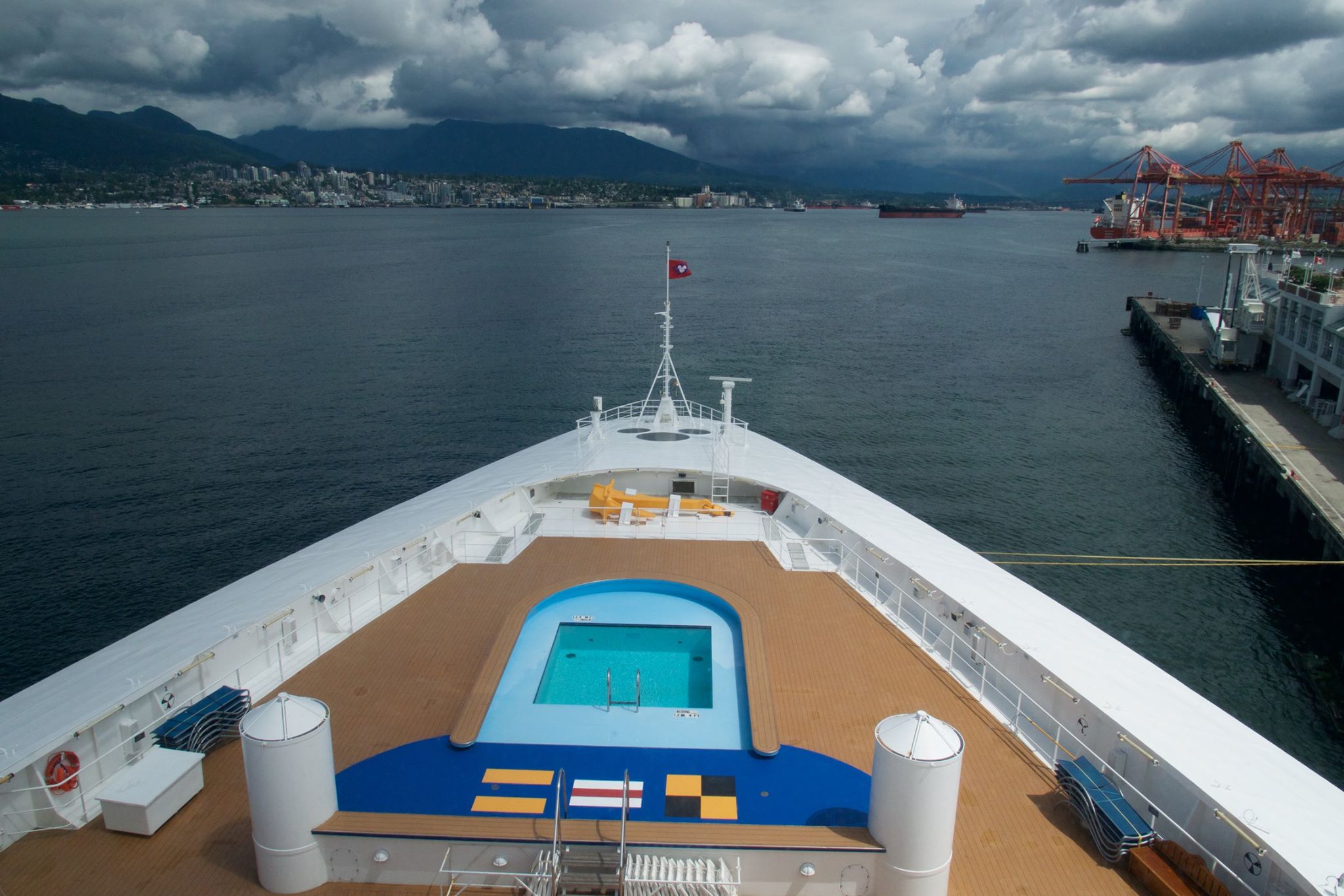
The drive from Snoqualmie, an east side suburb of Seattle, was pretty easy. The last few miles into Vancouver were a little slow, but it wasn't bad. Drives in the Pacific Northwest are lovely even when the weather is suboptimal, as it was that day. The ship docks at Canada Place, which, if you watched the Olympics in 2010, is the building they were always showing on the waterfront with the tent-like structures on top of the building. It's a different experience than Canaveral since they don't have an exclusive lease on the building, but it's still relatively efficient. The weird thing is going through US customs to board, though I suppose that makes more sense than doing so in Skagway.
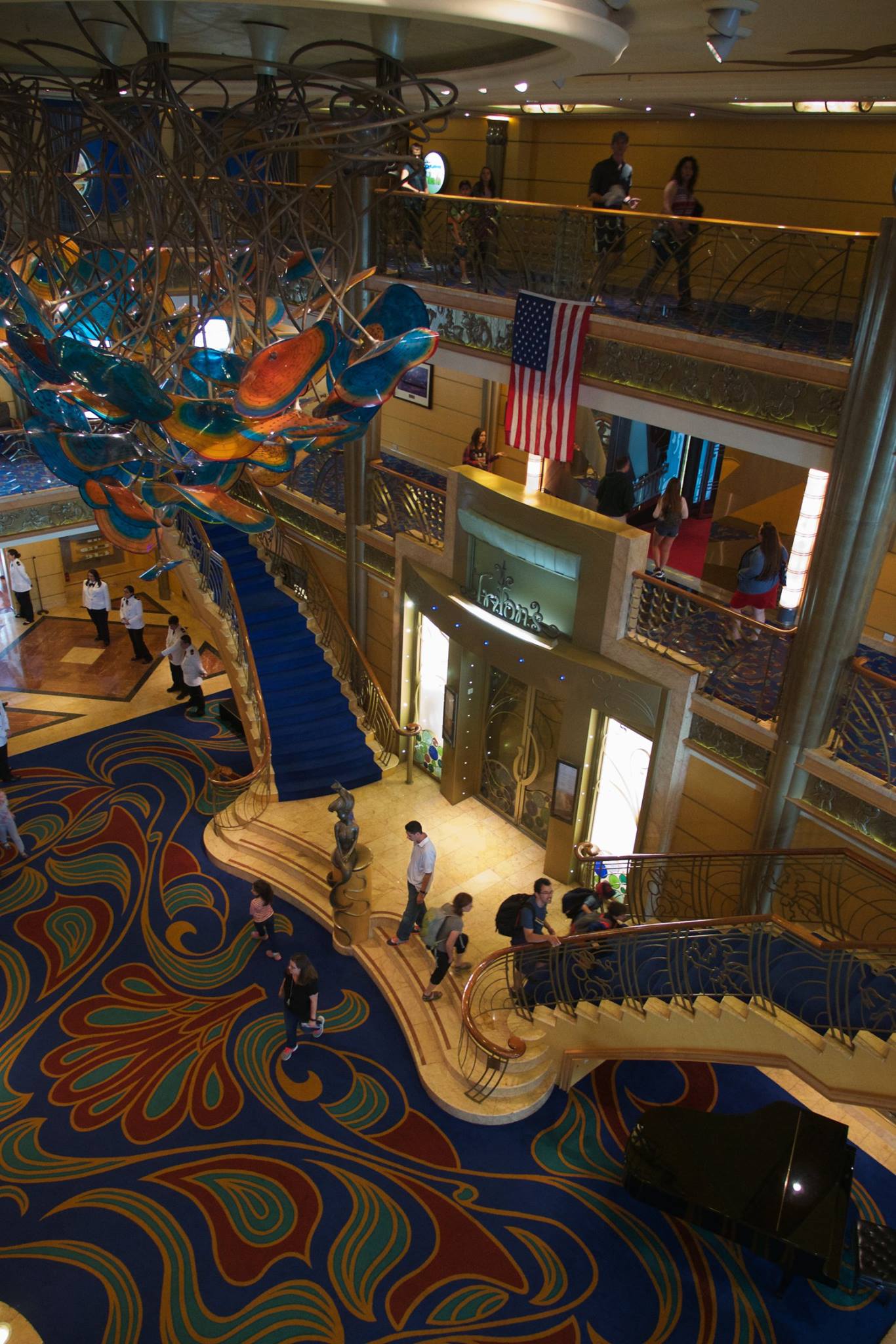
I had some minor anxiety about the Wonder, because it's the second oldest ship in the fleet (1999), and it hasn't had the significant drydock overhaul that the Magic had about a year and a half ago. The Magic is a year older, but they stripped it down to the steel, and in many places started over. I hadn't been on it before, but we were on the second cruise out after that drydock, and it was amazing. The Wonder ended up being about what I expected. Like Disney World itself, it feels like it opened yesterday unless you look harder. The constant upkeep means the ship is in generally good condition, but there are places that are tired. So while the soft goods in the staterooms are all new, the dressers and such are a bit beat up. Ditto for certain interior areas, especially restrooms. While certainly very clean, it's not hard to find peeling wallpaper, chipped tiles and the like. The Animator's Palette restaurant has an old show that includes some very dated video screens. The grand drydock is coming in September, and everyone on the ship was buzzing about it. Regardless, there was no doubt you were on a high-end, Disney ship.
The pools were mostly open during the day, particularly the adult pool. The water was like bath water, so even on chilly days, especially the one in Endicott Arm, you could enjoy the water comfortably, unless you got out. I spent a little time in one of the adult hot tubs, but really should have done more. The exterior decks were really busy on the days at sea, because being on the inner passages made for plenty of beautiful scenery. As much as I figured that a verandah room wouldn't be worth it, now I'm rethinking that. The extra cost was significant, but maybe it would have been worth it.
Our stateroom was on deck 6, forward and starboard. We learned on the Magic (the ship's twin) that being aft meant a lot of engine noise, so we deliberately went forward. Originally, we booked an interior room, but knowing how we often retreat for a break, I was uncomfortable with the idea of a not having a window. As it turns out, we could get a very specific room rated as a "deluxe interior" room but with a window, partially blocked by the window cleaning apparatus. This turned out to be fantastic, and without spending a lot extra. Plus, we were always close to the theaters, the adult pool, the lobby and the bars. As with almost all of our cruises, we booked onboard previously, for 10% off the regular rates, plus an onboard credit, which in this case was $200 because of the length of the itinerary. Total savings was almost $800. Pro tip: Now they allow placeholder reservations for a flat $250. You'll get the discount and onboard credit without choosing a specific itinerary. We have two booked.
We learned in February on the Magic that the spas offer a lot of discounts if you'll book for the day of departure. That makes sense, because I don't imagine people are that anxious to spend an hour plus missing the departure party, dinner, entertainment and the like. So Diana and I booked hot stone massages. I unfortunately did miss a pretty dramatic sail under a low bridge in Vancouver, but it was worth it. This tiny, 4-10 Filipino woman managed to push the limits between pleasure and pain, and I felt amazing when it was done. The deal this time was I think 75 minutes for the price of 60, but I had an additional 20% off only because I asked if some genius designed the ship with the basketball court over the treatment rooms, since I heard a lot of banging around (this was the case).
The dinner food is about what we've come to expect, which is to say there are a lot of dishes that you wouldn't ordinarily get at a local restaurant. The presentation is fancy, and it's surprising how well they do given the sheer volume that they have to prepare. I'm not a foodie, so I may not be the best to judge. The first three nights were more or less the same menus we've seen on the Dream and Magic. It was the new things on the other nights that I found pleasing. I'm a picky eater, but they had a nice jerk chicken appetizer, surprisingly good turkey one night, and chicken schnitzel that was perfectly cooked. The desserts are all amazing, and while I had my share of variations on chocolate cake, I had Mickey bars every single night. That's seven of them. I don't know what to say, other than I love the dark chocolate that they use and the texture of the Mickey sprinkles. And hey, at WDW, that's $30 worth of ice cream novelties!
Breakfast and lunch were not nearly as robust as they are on the other ships, and I believe that has a lot to do with the fact that the Beach Blanket Buffet, in the upstairs aft position, is an old-school buffet line style layout. Compared to the newer Cabanas restaurants on the other ships, which feature long walk-up areas (no lines), there isn't enough room to serve much variety. This was pretty disappointing, but they will be converting the space in drydock. The quality was OK, it's just that it was mostly the same things every day. We didn't try Parrot Cay, the one downstairs restaurant that they lit up for a lunch buffet, but our servers indicated it was the same stuff. While disappointing, there was a day when they finally had the spinach orzo that I've had on the other ships, and it's fantastic. The taco bar that day was also surprisingly good.
The counter service and room service were what we've come to expect, which is the usual variety of pizza, burgers, chicken tenders and the like, plus the soft serve ice cream. For the most generic of American convenience foods, the quality is solid. The cool thing they had that we haven't seen before is soft pretzels, salted or cinnamon. We took advantage of in-room breakfast just once this time, because we ended up being up and about early enough (read: Eastern time) so it wasn't necessary.
I didn't drink a lot this trip. I don't know that I was ever even buzzed, which is unusual for me and cruising. I attribute this to the lack of a beach day and what I think was a cold that started the night of the Endicott sailing. I didn't really feel like myself until midday in Ketchikan, our last port (day 6). I had some fruity drinks, sure, but not many. One silly thing I like is that you can get the UK version of Strongbow aboard the DCL ships, which is not the overly-sweet stuff they switched to in the US.
Entertainment on a 7-night includes the expected three stage shows, as well as some filler magicians and comedians. We only did the stage shows, and the night that they were showing Finding Dory. On one hand, we were happy to see some refinements in The Golden Mickeys, the show that I think is playing on every ship. The main character, a "stage manager" forced to host an awards show (don't get Diana started on the silly stereotypes), gets more time on stage singing now, and they've added a lot of new projection effects and dancing. Those revue-style shows can be pretty "meh," but the improvements help. Toy Story: The Musical, exclusive to the Wonder, felt generic and uninspired, with forgettable songs. I was disappointed. It's a slow-moving puppet show in some ways, without any big song and dance numbers. Dreams, which we've seen on other ships, was just OK. All three shows suffer from the same problem: The chorus is tracked and the choreography isn't that interesting. I think there are four or five actors at best that really get to show their talents, and that's unfortunate. It's entertaining, but knowing what the company is capable of, I know they can do better.
We also saw part of The BFG, but Simon got bored with it and we bailed. We ended up watching Finding Dory a second time, because it really was a great follow up, a decade later. The other movies we had either seen or weren't that interested in.
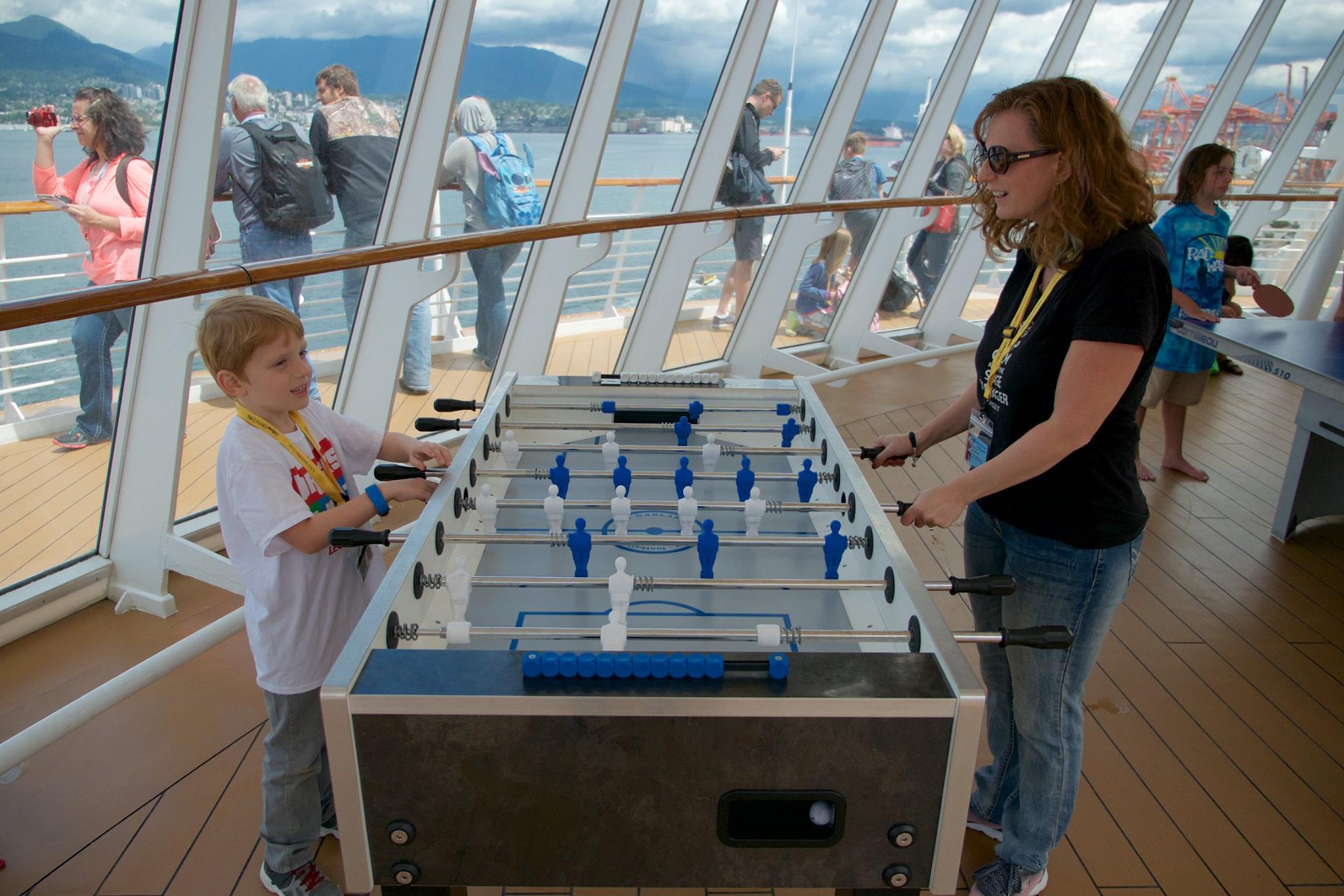
As for other activities, we did a lot of trivia sessions, but didn't win any of them. Diana and I were late and missed the theme park trivia, which we would have likely cleaned up in. Joe and I did a tour about the design of the ship, which in many ways was similar to the offering on the Dream done in one of the bars with a slide deck. Of course Simon had to play foosball, so that was a win. Character meets were frequent, and although we didn't go to any on purpose, we met Daisy in the Castaway Club gold/platinum reception, and Ariel was very generous with her time when Simon ran into her in the hall. Oh, and that reception was awesome, with free drinks and officers chatting about. We made paper ships one afternoon.
Our first full day was at sea, following various inner passages between Vancouver and the US border. It reminded me a little of driving through various parts of I-5 between Seattle and Portland, only on water with a giant cruise ship. There were waterfalls all over the place, and these beautiful valleys. While the channels were not wide, the depth of the water was a staggering 150m or more, as you could simply draw a line from the mountain sides into the water. There were whales to see, but I was never on deck at the right time to see them. Kind of kicking myself for that. Double kick because the last day was at sea through many of the same routes.
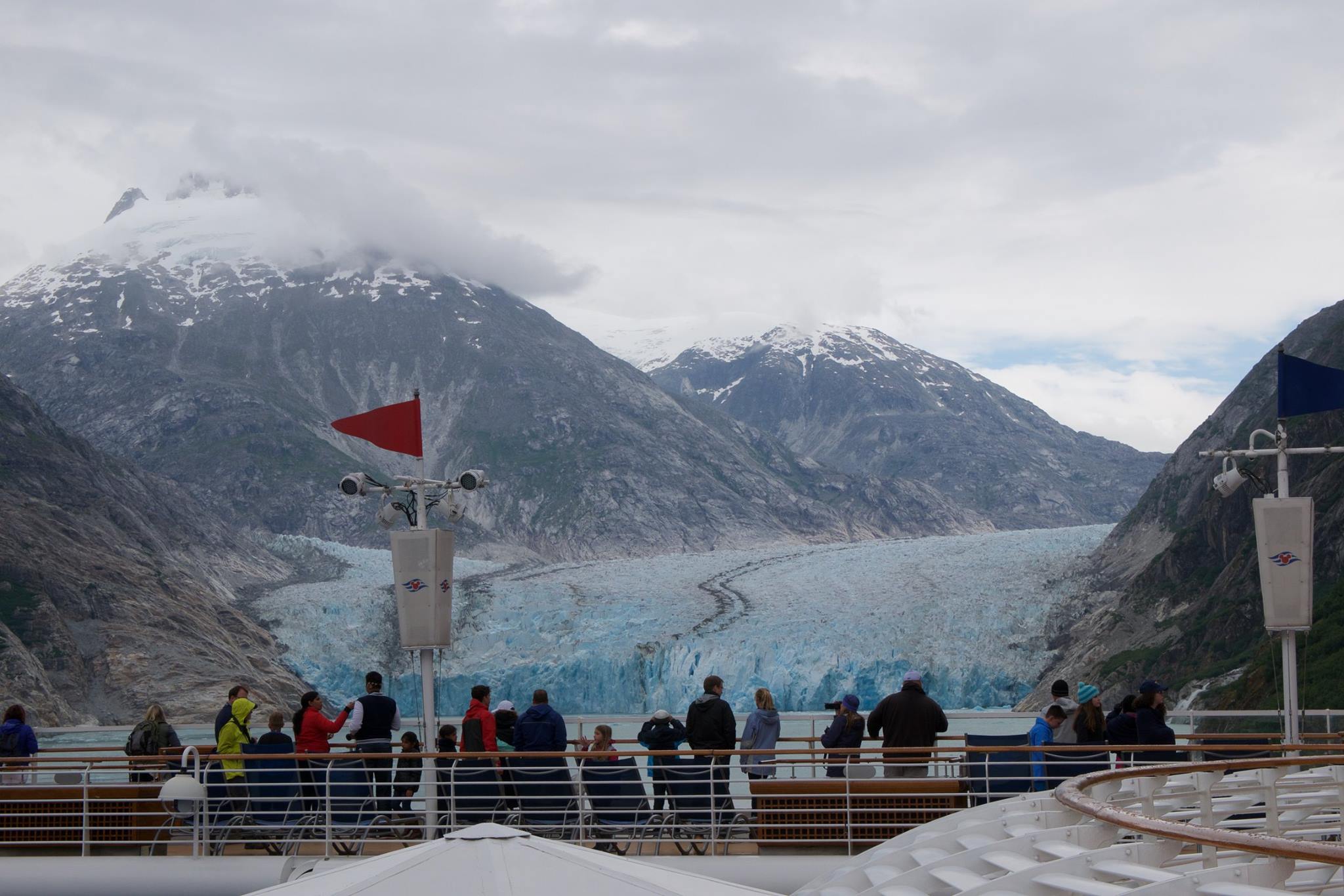
The second day was scheduled to go up Tracy Arm, a fjord south of Juneau with massive glaciers at the end. However, because of the massive chunks of ice in the fjord, the captain, along with a "pilot" that joined us onboard from the state, made the decision that it wouldn't be safe, and we instead went up the adjacent Endicott Arm. This was a gradual sail inland, with impossibly high mountains on both sides. Each valley off the sides was covered in waterfalls in a way that reminded me of the helicopter ride over Kauai's ancient volcano site. The difference was the snow at the top. There were more and more chunks of ice as we got closer to the glacier at the end. Finally, as we made a final turn, there it was, in all of its blue glory. A smaller ship was already there, with people boarding inflatable rafts to get a closer look. I imagine that we were at least a mile and a half away, and it still looked enormous. They rotated the ship you could see it from all over, and it felt almost like the ship was wedged between the sides of the fjord. It was cold, but there was some kind of spiked hot chocolate I had in a souvenir cup that was delicious, and I hate hot drinks. The kids spent time playing shuffleboard with some kids from Hawaii, which was neat because we were in Alaska.
This experience was, like much of the trip, an amazing contrast between the vastness of nature and the smallness of its inhabitants. Even the ship, a gigantic, modern marvel of engineering with thousands of people on it, seemed small in this context. If ever you need perspective about life, this is the kind of experience that gives it. Alaska is every bit as beautiful as Hawaii, only in different ways.
In part 2, I'll talk about the specific places that we visited in each of the three ports.
The most uninteresting of gadget purchases
posted by Jeff | Friday, July 15, 2016, 7:55 PM | comments: 0I had to buy a new cable modem this week, after getting six years out of the old one. I suppose I shouldn't complain, because over that time I probably saved $150 versus renting the cable company's modem. It's just that spending anything at all feels lame because there isn't really any gadget that you could buy that's less interesting.
So what happened? The going theory is a lightning hit. When we got back from our vacation, the "receive" light on the modem was green instead of blue, meaning that it was only receiving on one channel. It can normally do up to 8, which is why it could (in theory) download as fast as 304 Mbits, but was stuck at 38 or less (we pay for 50). It was also dropping connection any time we really started pulling data down, as in streaming video. That made work hard, because it's not uncommon for Simon to be watching something, maybe Diana watching something else on her iPad in her sewing studio, and me working with an IP phone, VM connections, desktop sharing and regular Interneting. It was a real drag.
So after a service call yesterday morning, I bought a new modem from BestBuy (on sale, cheap as Amazon), but it didn't work. Second guy came out late, and the new modem was putting out too strong of a signal, so it was likely defective. Shit. Then, this morning, I went and exchanged it for another, and sucked it up to buy a more expensive one that could go up to 300 Mbits if I wanted to pay for it. Sure enough, they lit it up, and I was back to my 50-ish down, 5 up. The little plastic object has since been banished to a place under my desk, where I will never think about it again until it breaks.
Unfortunately, I still have one other issue, in that my Airport Express won't see the backup drive that I have connected to it. That's a drag, because that's where we backup our stuff from the desktop and laptops. I imagine it could also be lightning related, and annoying because the routers are not as cheap, and I lost one about 18 months ago to lightning. Come to think of it, I should double check the grounding on the outside of the house.
Still, boring purchase. On the bright side, I'm not spending a lot on the business lately (pretty much anything related to connectivity is a business expense because of the sites), so it's not a big hit. It just doesn't do anything, except enable everything.
Vacation clarity
posted by Jeff | Friday, July 15, 2016, 2:15 PM | comments: 0Our trip to Alaska was amazing, and it's the longest vacation I've had since our honeymoon in 2009. That was entirely too much time in between. The last few years in particular we have limited our trips to five or six days at most. A week and change is better because I think it's enough time to fully bring you out of your routine. When you're able to get out of that routine, it makes a difference in the way you see life and the world around you. You get clarity.
I've been thinking a lot about the things in life and work that cause the most problems, and it's usually the things that you can't see. I also believe that the issues are invisible to an extent because they're too close to you. It's a terrible analogy to use actual sight, but there's some truth to the idea that some things are too close to obviously cause a problem. I don't have the magic code for seeing those issues.
Still, I do see one way to surface problems, and that's to get the hell away from them. Unplugging and getting away from regular daily life, and being distracted by some of the most beautiful things in nature ever, definitely have a way of bringing things into focus. I remember lying in bed, the last night we were in Seattle, feeling like everything about my world was clear. It doesn't all make sense, but I can see it at least. Clarity makes it easier to act.
What did I need to get away from? Well, daily life, I guess. The grind. I was feeling slightly unhappy and stressed, and I wasn't sure I entirely understand why. Now I get it, and I know where I can make adjustments. I just needed clarity, and a long vacation gave me that.
Home is complicated
posted by Jeff | Wednesday, July 13, 2016, 7:10 PM | comments: 0We returned home last night after 10 days away. We went to Seattle, where we joined my brother-in-law's family and drove up to Vancouver, where we boarded the Disney Wonder and did a 7-night cruise to Alaska. It was easily the biggest vacation I've taken (in terms of distance and cost), and it was completely amazing. So much to write about. However, it was the time in Seattle, or more specifically the eastside suburb we lived in, that I found challenging.
We left Seattle in late 2011 after living there for two years, to chase our financial goals as they related to my unsold house. I've written about that countless times, and yes, I still have a hard time letting go of that decision as awful. As a family, we returned in 2012 for week or so, and then I went back for a day in 2013 to interview at Microsoft again (the job was, to say the least, not a good fit). I haven't been back since, so that's more than three years.
Being back in Snoqualmie was emotionally weird for us. While we only lived in the area for two years, being there made us very happy. It's such a naturally beautiful place, full of interesting and diverse people and a thriving technology job market. I think it is, objectively, an amazing place to live. Certainly it has its drawbacks, mostly the cost of housing, earthquake potential and a lack of theme parks, but it's mostly a winning place. The night we got there last week, on my birthday, it was amazing to be there in bed and just listen to the sound of trees and birds outside, with the window open.
This is not to say that we don't like living in Orange County. We live a life mostly free of cold weather, and we enjoy theme parks, rocket launches and cruises in the tropics. The flat land and hurricane potential isn't ideal, but it's no deal breaker. It's awesome here in a completely different way.
That's the thing that we struggle with... home is not easy to define. I think we wish that there was an ideal world where we could simultaneously live in two places. I suppose the only thing that we can say that home is not is Ohio. That's a weird thing to consider, that the place you lived most of your life isn't really a place you want to be. It isn't dislike as much as indifference.
Yesterday was the three-year anniversary of my arrival in Florida, and it's been a pretty great three years. I have no desire to move again, but I try to be pretty zen about what it means to be "home."
Deferring the kudos
posted by Jeff | Friday, July 1, 2016, 3:00 PM | comments: 0I received a really great email today from my client, giving me praise for leadership and execution. I've said before that I don't generally seek out validation, but it sure feels great to get it when it does come. It probably doesn't come enough, even if I'm not willing to admit that. As good as it may feel, sometimes it makes me uncomfortable, especially in a leadership position where I feel my job is to serve the people and process to move things forward.
That said, my response was largely to defer the positive feedback to the team. While I generally find myself adapting my views on everything over time, the one thing that I keep reinforcing is that you and your success are only as good as the people around you. Being a one-man band is hard and failure prone, but if you surround yourself with an amazing guitarist and drummer, your band can rock. (What an awful metaphor, but I'm sticking with it.)
I don't intend to trivialize how hard it is to surround yourself with good people. It's not easy. Professionally, especially when your influence on hiring may be limited, it's hard to get good people. (In your personal life, it's much easier to eject the people who mostly bring you down.) I think that may be one of the reasons I'm somewhat fanatical about acquiring, training and retaining good people. It makes an enormous difference in the way things go in your day to day work. I can't understand companies that don't get this, and working at a company that gets it is part of the reason I dig it.
Always, always be sure to high five your team. It sucks for everyone when the only feedback they get is when something isn't going right. It affects morale, retention and productivity. If you're in a leadership position, part of that is deferring the kudos as they come.